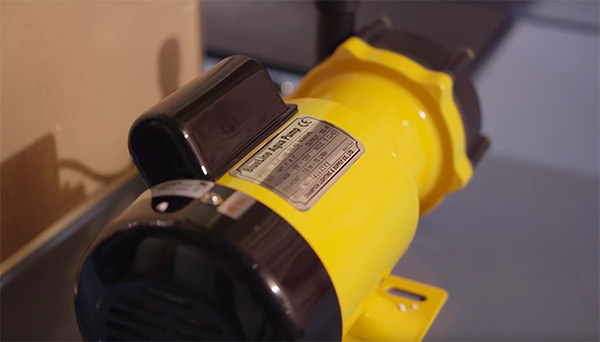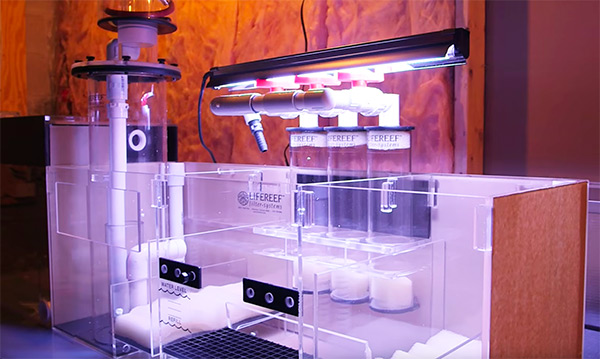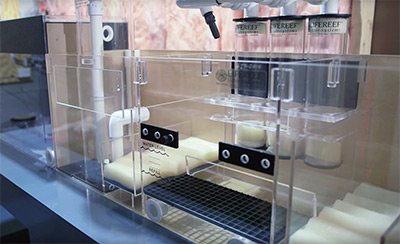I hate clutter. Unfortunately, clutter and reef aquariums come hand in hand, especially as the devices start to pile up. Want to add a calcium reactor? Get ready to deal with power cords going to the main pump, the feed pump, and the solenoid, not to mention tubing going to and from the tank as well as the CO2 canister. Even something as simple as a protein skimmer can involve multiple devices. As reefkeepers add more gadgets and the complexity of the whole system increases, the reef tank can become a snake pit of wiring and tubing. For neat freaks like myself, a sump is a godsend.
What is a sump? A sump is basically a secondary tank that your main display tank drains down into. Why do I love these things so much? Let’s go through some of the advantages:
Isolates clutter and noise
First and foremost, a sump helps manage that clutter problem I described above. A sump is a great place to relocate all your equipment. In systems that are just a stand-alone tank, the clutter is all over the display tank, which takes away from the aesthetic of the whole system. Most reefkeepers I know like to tinker a bit and try out new technology, so what starts as an elegant system starts to get more and more cluttered. A sump gets that clutter out of the main display.
Another benefit of moving all of the equipment out of the main display tank and into a sump is the noise isolation. Depending on how the sump system is implemented, the reef aquarium can be completely silenced.

Surface skimming
The second big benefit to a sump is the surface skimming that an overflow provides. A big problem with tanks without an overflow is that scum tends to collect on the surface. If left unattended, the surface scum can affect the gas exchange that occurs at the surface of the water, which can have an effect on certain chemical parameters, especially pH. When the water in a main display drains down into a sump, the surface is cleared up nicely.
The drains work passively. It is not one pump taking water out of the display and another pump in the sump putting it back. The reason for this is because there is no way to adjust both pumps to remove and return exactly the same amount of water. Over time one of these two tanks would overflow.
Just for the sake of argument, what if you were to get two of the exact same pump? It still won’t work. Pump flow rates vary just a little bit from pump to pump. Furthermore, there are different head pressures put on by plumbing, and then even more variables come into play, such as algae growth. The list of potential problems goes on and on. In short, there is only one return pump that sends water into the display tank and then the water passively overflows back down into the sump.
When designing a sump system, make sure your drainage capacity is not exceeded by the return capacity of the pump. In all the systems I have here at Tidal Gardens, I go overboard on the drains. I want to avoid overflows of the main display tanks at all costs, and that includes random stuff like a snail going down into an overflow and blocking it. The drain lines here range from 1.5” to 2” in diameter, which is very high capacity.
Additional water volume = stability
The third advantage to having a sump is it provides additional water volume. Water volume is nice because it makes the overall system more consistent in terms of temperature and water chemistry. Changes simply happen more slowly in larger volumes of water. I believe in the saying that nothing good happens quickly in a reef aquarium. Having that extra water is like a buffer for disaster.

Flexibility
The fourth advantage is flexibility. A sump can be as simple or as complicated as you want it to be. You can set up a sump in many different ways. There are plenty of people who use a regular glass aquarium as a sump. Also, don’t feel that you have to plan out every detail as if it were a bespoke suit. One idea I got from a fellow hobbyist (Miss Saltwater Tank) is to have one compartment completely empty because it is hard to anticipate what you might need in the future. In her setup, that blank space was used as a hospital tank for corals that needed space, a nursery for breeding fish, and who knows what else over the years.
Conclusion
If you have a desire to keep things around your tank more organized, consider installing a large sump in your next reef aquarium build. They do a great job of moving most of the equipment away from your main display tank and provide other benefits that help maintain a healthy system.



